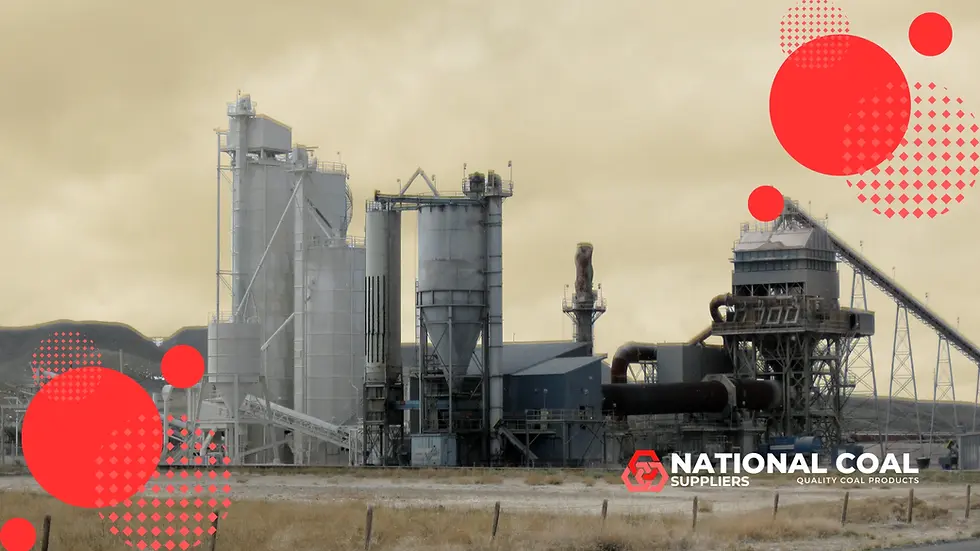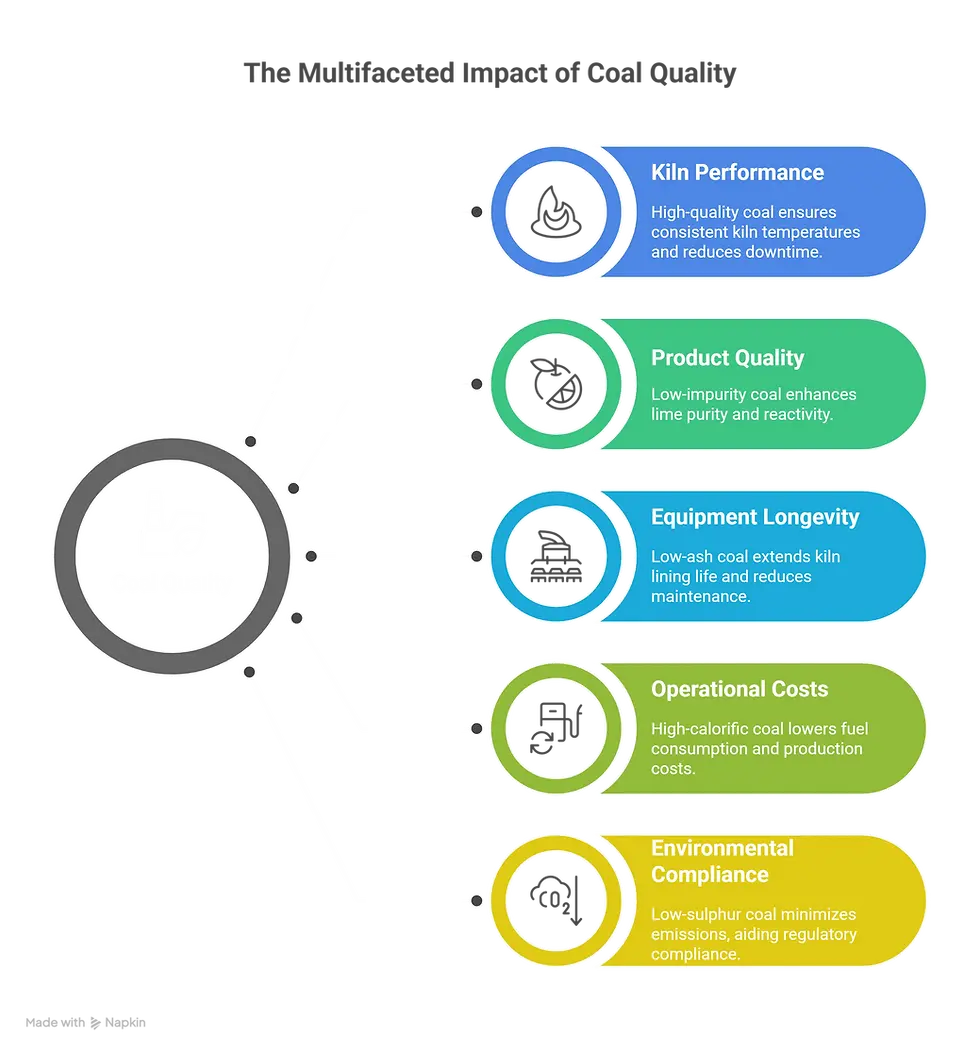What is the Best Coal for Lime Production in South Africa?
- National Coal Suppliers

- Aug 7
- 8 min read
Explore essential coal specifications and types ideal for lime production in South Africa. Learn how coal quality impacts kiln efficiency, lime purity, and operational costs.
About the Author: National Coal Supplier is a trusted source for 10,000+ monthly readers seeking industry insights on coal mining, gold, and chrome. Backed by industry analysts and technical writers, we provide accurate data on grades, specs, and sourcing of coal types, including peas, small nuts, and duff, serving buyers, exporters, and energy firms.

key takeaways:
Low ash and sulfur coal boosts lime purity and kiln life
High carbon coal ensures stable, efficient combustion
Coal peas and small nuts sizes optimize feed and burning
Alternatives like petcoke or biomass have trade-offs
Reliable testing and supplier audits guarantee fuel quality
Choosing the right coal for lime production isn’t just about heat, it’s about precision. The coal type directly affects kiln performance, lime purity, and overall production costs. For South African lime producers, coal quality is key to achieving consistent results and meeting environmental standards.
This article breaks down the coal properties that matter, compares fuel options, and outlines what buyers need to know to source reliable, high-performance coal for efficient lime calcination.
LOOKING FOR A RELIABLE COAL SUPPLIER? We supply and deliver high quality grade coal to meet the needs of clients looking to increase their power and fuel efficiency. Contact us for pricing, specs, or bulk orders.
Why Coal Quality Matters for Lime Production

Producing high-purity lime depends heavily on choosing the right coal. The fuel you select affects every stage of lime production, from how efficiently the kiln operates to the quality of the final product. Key reasons why coal quality matters include:
Kiln Performance: High-quality coal burns more consistently, maintaining steady temperatures needed for proper calcination and reducing downtime.
Product Quality: Impurities like ash and sulphur in coal can contaminate the lime, lowering its purity and reactivity.
Equipment Longevity: Excessive ash and slag from poor coal wear down kiln linings faster, increasing maintenance costs and downtime.
Operational Costs: Efficient combustion of high-calorific coal reduces fuel consumption and lowers overall production expenses.
Environmental Compliance: Low sulphur coal minimizes harmful emissions, helping meet regulatory standards and reduce pollution.
Selecting coal low in ash and sulphur, but high in calorific value, is essential to support consistent combustion and long-term operational success. Learn more about how to boost boiler efficiency with the right coal products.
Key Coal Properties: Ash, Sulphur, Calorific Value
Coal used in lime kilns must meet strict criteria:
Ash Content: Ash should be under 10%, ideally below 6%. Excess ash forms slag, clogs kilns, and damages refractory linings.
Sulphur Content: High sulphur causes off-gassing, increases SO2 emissions, and lowers lime purity. Acceptable levels are typically below 1%.
Calorific Value: Target >25 MJ/kg for steady kiln temperatures and reduced fuel consumption.
Low ash coal used in lime kilns minimizes cleaning and maintenance downtime. It also helps prevent kiln lining degradation, a common issue when ash melts and fuses with the interior surface.
Impact on Kiln Efficiency and Lime Purity
Coal type directly affects the efficiency of the calcination process. High-carbon coal for lime production burns hotter and more consistently, ensuring complete limestone conversion.
It also supports better combustion control in rotary kilns, which is critical for energy cost savings and consistent lime reactivity. Impure coal leads to uneven burning, increasing the risk of underburned or overturned lime.
Poor fuel consistency also raises operational costs. Frequent adjustments in airflow and feed rates lower energy efficiency and increase emissions. Using the ideal coal specifications for lime burning ensures predictable results, fewer production interruptions, and longer kiln lifespan. Learn more on how to calculate Coal consumption per ton of steam.
Typical Coal Specs for South African Lime Kilns

Coal requirements in South Africa are shaped by kiln design, regulatory standards, and limestone characteristics. Understanding these specs is key to sourcing fuel that performs reliably.
Typical Ranges: Low Ash, Acceptable Sulphur Levels
South African lime producers prefer coal with:
Ash content: 5–8% (lower is better)
Sulphur content: 0.5–0.9%
Fixed carbon: >55%
Volatile matter: 20–30%
These values align with South African coal standards (SANS) and support clean burning and low emissions. Coals outside this range may require blending or additional treatment.
High ash coal leads to more frequent kiln shutdowns, increased waste disposal, and accelerated equipment wear. Keeping within the ideal ranges also simplifies compliance with environmental regulations, especially for plants near urban or sensitive ecological zones. Understanding the difference between Peas and Small Nuts will allow you to make a informed decision on which product to choose.
Calorific Value Benchmarks
Energy output matters. For efficient lime calcination, coal must provide high heat with minimal residue. Ideal calorific values fall between 25–30 MJ/kg. This ensures fast heating cycles and reduces fuel volumes needed per ton of lime. High heating value also supports energy cost savings in continuous kiln operations.
A higher calorific value also means more consistent kiln performance across shifts. When lime kilns operate with subpar fuel, fluctuations in temperature cause variability in product quality. This can affect downstream uses of lime, such as in water treatment, steelmaking, or chemical processing.
Comparison of Coal Types Used in Lime Kilns

Choosing the right coal means balancing performance, availability, and emissions compliance. Here’s how different options compare, including common coal sizes like coal peas and small nuts that are frequently used in lime production:
High Carbon, Low Ash Coals
Anthracite and high-quality bituminous coals rank highest for lime production. Their benefits include:
High fixed carbon (70%+)
Low ash (under 6%)
Stable, high-temperature combustion
Availability in sizes like coal peas and small nuts, which offer consistent feed rates and efficient burning in kilns
These fuels provide the best control for rotary and shaft kilns. Their clean burning reduces clinker formation and protects kiln linings. The size consistency of coal peas and small nuts also supports automated combustion control systems, helping plants maintain steady flame profiles and ensure product consistency.
Alternatives and Their Constraints
Some producers explore alternatives like petcoke, refuse-derived fuel (RDF), and biomass. While these can reduce costs or emissions, each option has trade-offs:
Petcoke: High heat output but very high sulphur content, requiring scrubbers and emissions controls.
RDF/Biomass: Lower emissions but inconsistent calorific values and higher volatile matter, which can cause combustion instability.
These alternatives may suit hybrid kilns or partial substitution strategies but are rarely standalone solutions for producing high-grade lime.
Using non-coal fuels often requires costly equipment upgrades or regulatory permits. For instance, RDF can cause fouling in kiln ducts, while biomass fuels may need pre-drying and dry storage to maintain combustion efficiency.
Practical Buying Guidelines for South African Buyers
Coal selection goes beyond specs. Logistics, testing, and quality assurance all play a role in securing reliable fuel for your kiln.
Regional Availability and Transport Considerations
South Africa’s main industrial coal hubs include Mpumalanga, Limpopo, and KwaZulu-Natal. Buyers should factor in:
Proximity to mine or siding
Transport costs per tonne
Consistency of supply throughout the year
Bulk supply from trusted sources reduces delivery interruptions that can stall kiln operations.
Transport reliability is just as important as quality. Delays in delivery can halt production, especially in continuous operations. Consider contracts with buffer stock clauses or storage solutions near your site.
Testing, Supplier Audits, Quality Certificates
Don’t rely on spec sheets alone. Reputable suppliers provide:
Certificates of analysis (CoA) per batch
Access to test results on ash fusion, fixed carbon, sulphur
Regular quality audits and performance reviews
Ensure that the coal matches your kiln’s needs across all operating seasons. Sample testing is essential before committing to large volumes.
Visiting supplier facilities can also reveal key differences in handling, testing, and loading practices. These small factors can influence contamination levels and fuel consistency.
Operational Tips for Using Coal in Lime Kilns
Even the best coal underperforms if combustion isn’t properly managed. Follow these practices to protect your equipment and output quality.
Monitoring Combustion, Avoiding Excess Sulphur, Best Practices
Install combustion monitoring tools to track:
Flame temperature
O2 and CO levels
Sulphur dioxide (SO2) emissions
Keep sulphur below 1% to avoid off-spec lime. Excess sulphur can react with calcium oxide and alter reactivity. Continuous analysis helps maintain product consistency.
Modern kilns often use inline sensors and stack monitoring tools to catch deviations early. Adjustments in air-fuel ratios and feed rates can be automated based on sensor feedback.
Control Strategies to Maintain Lime Quality & Kiln Longevity
Avoid rapid temperature swings. Optimize airflow, feed rate, and burner position to ensure:
Uniform calcination
Reduced refractory wear
Consistent lime purity
Rotary kilns benefit from programmable logic control (PLC) systems for better combustion stability.
Routine training and calibration of control systems are also vital. Operators should be trained to spot irregular combustion patterns and make real-time decisions. Consistent operating practices reduce the chances of over burning or under burning the lime.
Final Thoughts
The success of your lime production process depends heavily on the coal you choose. From reducing emissions to maintaining product purity, every aspect of kiln performance is tied to fuel quality. Low ash, high carbon coal remains the gold standard, especially for South African operations where consistency and compliance matter.
For reliable supply, flexible volumes, and expert support, trust National Coal Suppliers, South Africa’s leading coal producer. Contact us today to discuss your specific coal requirements and secure a partner who delivers quality on time, every time.
Frequently Asked Questions
Can coal blending improve performance in lime kilns?
Yes. Blending different coal types allows producers to adjust ash content, sulphur levels, and calorific value to meet specific kiln requirements. It’s commonly used to balance cost and performance, especially when premium-grade coal is in limited supply. However, proper testing is critical. Improper blends can cause unstable combustion, buildup in kiln linings, or inconsistent lime quality. Work with a coal specialist or lab to develop the right blend for your operation before making bulk purchases.
How does coal particle size affect lime kiln operation?
Coal particle size impacts how efficiently it burns in the kiln. Particles that are too fine may combust too quickly, causing uneven heating and increased emissions. Oversized coal, on the other hand, burns slowly and may not fully combust, reducing energy efficiency. The optimal size depends on kiln type, but most operations target a mid-range size for consistent flame control and fuel utilization. Uniform sizing through screening ensures predictable combustion and helps maintain steady lime output.
Is there a seasonal impact on coal performance in kilns?
Yes. Moisture content in coal can fluctuate with the seasons, especially if it's stored outdoors. During wet or humid months, coal may absorb more moisture, reducing its heating value and increasing smoke or unburned residue during combustion. This affects kiln efficiency and product quality. To mitigate this, coal should be stored under cover or in climate-controlled areas. It’s also advisable to test moisture content before use, particularly during the rainy season or periods of high humidity.
What role does coal origin play in lime production?
The geological origin of coal influences its composition, including ash fusion temperature, volatile content, and sulfur concentration. For example, South African coals are known for their relatively low sulfur and moderate ash levels, making them well-suited for lime production. In contrast, coals from other regions may require more processing or blending. Knowing your coal’s origin helps predict how it will behave in your kiln and informs decisions around combustion settings and emissions control strategies.
Are there risks in switching coal suppliers frequently?
Yes. Changing suppliers without thorough testing can disrupt kiln performance. Even if specs appear similar on paper, small differences in ash fusion temperature, moisture, or mineral content can lead to unexpected outcomes, like slagging, increased emissions, or reduced lime quality. Frequent switching can also introduce supply chain risks and complicate quality control. It's best to conduct performance trials before transitioning to a new supplier and maintain documentation on past coal behaviour to inform purchasing decisions.



